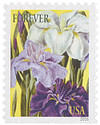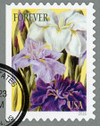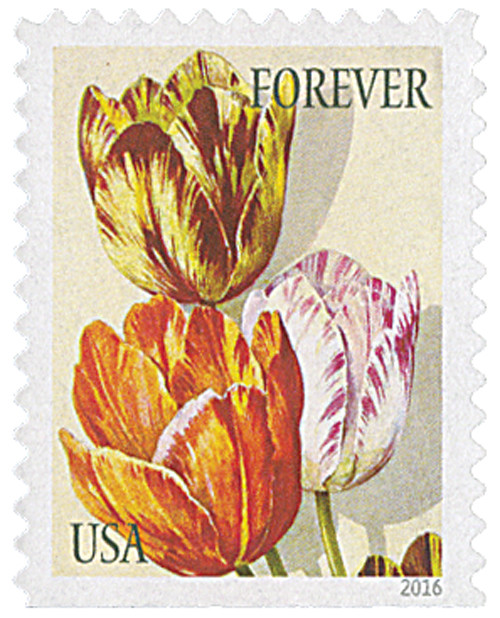
# 5048 - 2016 First-Class Forever Stamp - Botanical Art: Japanese Irises
US #5048
2016 Japanese Irises – Botanical Art
- Celebrates botanical artwork in American nursery catalogs printed between 1891 and 1912
Stamp Category: Definitive
Set: Botanical Art
Value: 49¢ First Class Mail Rate (Forever)
First Day of Issue: January 29, 2016
First Day City: Atlanta, Georgia
Quantity Issued: 60,000,000
Printed by: Ashton Potter
Printing Method: Offset
Format: Booklets of 10 OR Double-sided booklets of 20
Tagging: Nonphosphored type III, block tag applied
Why the stamp was issued: To continue the tradition of printing floral-themed US stamps.
About the stamp design: Pictures Japanese irises from an American nursery catalog printed between 1891 and 1912. The catalog was from The New York Botanical Garden’s Nursery and Seed Catalog Collection.
First Day City: The First Day of Issue Ceremony was held at the American Philatelic Society’s AmeriStamp/Southeastern Stamp Expo. at the Hilton Atlanta in Atlanta, Georgia.
About the Botanical Art set: 10 stamps all picturing different artwork from a 100+ year old American nursery catalog. Species pictured include: corn lilies, tulips, dahlias, stocks, roses, Japanese irises, petunias, and jonquils.
History the stamp represents: Gardening flourished in Mesopotamia several centuries before Christ was born. Assyrian King Sargon II noted, “the gardens… were the most pleasant features of the city…”. As they evolved and spread to other civilizations, gardens diversified.
The temple gardens of Mesopotamia were designed to represent sacred groves. Royalty and the upper class followed suit, creating courtyard gardens within the walls of palaces.
Ancient Romans created gardens as sanctuaries from the large urban population. Members of the Roman Empire were among the first to exchange information on botany and share seeds and plants.
Chinese and Japanese gardens captured the beauty of mountains and streams. However, Chinese gardens were intended to be viewed from within while the Japanese were designed to be enjoyed from outside the perimeter.
Public gardens were introduced during the Renaissance. Throughout the reign of Louis XIV, the French constructed enormous gardens glorifying the monarch and the notion of mankind dominating nature.
Although designs have changed over time, many ancient traditions can be seen in modern gardens – bringing beauty and tranquility to today’s world.
US #5048
2016 Japanese Irises – Botanical Art
- Celebrates botanical artwork in American nursery catalogs printed between 1891 and 1912
Stamp Category: Definitive
Set: Botanical Art
Value: 49¢ First Class Mail Rate (Forever)
First Day of Issue: January 29, 2016
First Day City: Atlanta, Georgia
Quantity Issued: 60,000,000
Printed by: Ashton Potter
Printing Method: Offset
Format: Booklets of 10 OR Double-sided booklets of 20
Tagging: Nonphosphored type III, block tag applied
Why the stamp was issued: To continue the tradition of printing floral-themed US stamps.
About the stamp design: Pictures Japanese irises from an American nursery catalog printed between 1891 and 1912. The catalog was from The New York Botanical Garden’s Nursery and Seed Catalog Collection.
First Day City: The First Day of Issue Ceremony was held at the American Philatelic Society’s AmeriStamp/Southeastern Stamp Expo. at the Hilton Atlanta in Atlanta, Georgia.
About the Botanical Art set: 10 stamps all picturing different artwork from a 100+ year old American nursery catalog. Species pictured include: corn lilies, tulips, dahlias, stocks, roses, Japanese irises, petunias, and jonquils.
History the stamp represents: Gardening flourished in Mesopotamia several centuries before Christ was born. Assyrian King Sargon II noted, “the gardens… were the most pleasant features of the city…”. As they evolved and spread to other civilizations, gardens diversified.
The temple gardens of Mesopotamia were designed to represent sacred groves. Royalty and the upper class followed suit, creating courtyard gardens within the walls of palaces.
Ancient Romans created gardens as sanctuaries from the large urban population. Members of the Roman Empire were among the first to exchange information on botany and share seeds and plants.
Chinese and Japanese gardens captured the beauty of mountains and streams. However, Chinese gardens were intended to be viewed from within while the Japanese were designed to be enjoyed from outside the perimeter.
Public gardens were introduced during the Renaissance. Throughout the reign of Louis XIV, the French constructed enormous gardens glorifying the monarch and the notion of mankind dominating nature.
Although designs have changed over time, many ancient traditions can be seen in modern gardens – bringing beauty and tranquility to today’s world.















